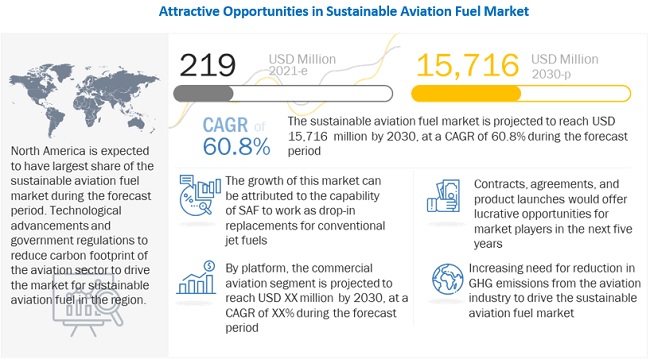The global sustainable aviation fuel market report provides an analysis of the market from 2020 to 2030. It discusses the industry and technology trends that are currently prevailing in the sustainable aviation fuel market, along with the drivers, restraints, challenges, and opportunities. The sustainable aviation fuel market is projected to grow from USD 219 million in 2021 to USD 15,716 million by 2030, at a CAGR of 60.8% during the forecast period. This growth can be attributed to the increasing need for reduction in the GHG emissions from the aviation sector. The increase in air passenger traffic will lead to rapid growth in the procurement of aircraft and rise in aircraft fleet, subsequently driving the demand for alternative solutions to increase the fuel efficiency. In order to meet the emissions reduction targets, aviation will need to adopt more revolutionary measures, particularly with regards to propulsion and sustainable aviation fuel are among the most promising new technologies. Aerospace, aviation, governments, and the energy sector alike are carefully considering the investments in renewable aviation fuel production and commercialization, in parallel with investments into other key sustainable technologies, to help realize their potential.

Based on fuel type, the biofuel segment of the sustainable aviation fuel market is accounted for the largest share during the forecast period. The production of biojet fuel is expected to scale up rapidly in the coming decade due to rapid developments in technological pathways to commercialize the use of alternative jet fuel. Countries such as Norway, the Netherlands, and the UK are contributing significantly to the long-term sustainability plans by funding bio jet fuel infrastructure.
Based on biofuel manufacturing technology, the hydroprocessed fatty acid esters and fatty acids - synthetic paraffinic kerosene (HEFA-SPK) segment of the sustainable aviation fuel market is accounted for the largest share during the forecast period. This growth can be attributed to the technology being most commercially available for the production of sustainable aviation fuel as well the optimum blending capacity approved for this pathway.
Based on biofuel blending capacity, the 30% to 50% segment of the sustainable aviation fuel market is expected to grow at the highest CAGR during the forecast period. The moderate blend capacity, drop-in facility in existing fuel systems, supply logistics infrastructure, and aircraft fleet allows to minimize the overall cost and cater to the volume demands from commercial and military aviation.
Based on platform, the commercial aviation segment of the sustainable aviation fuel market is accounted for the largest share during the forecast period. The growth of this segment can be attributed to the increase in the aircraft fleet of emerging economies in the commercial aviation sectors. The initiatives taken by the various commercial airlines, commercial airports, and aircraft manufacturers across the globe in adoption of renewable jet fuel is driving the growth of this segment in alternative aviation fuel market.
Get Sample Here: https://www.marketsandmarkets.com/requestsampleNew.asp?id=70301163
About MarketsandMarkets™
MarketsandMarkets™ provides quantified B2B research on 30,000 high growth niche opportunities/threats which will impact 70% to 80% of worldwide companies’ revenues. Currently servicing 7500 customers worldwide including 80% of global Fortune 1000 companies as clients. Almost 75,000 top officers across eight industries worldwide approach MarketsandMarkets™ for their painpoints around revenues decisions.
Our 850 fulltime analyst and SMEs at MarketsandMarkets™ are tracking global high growth markets following the "Growth Engagement Model – GEM". The GEM aims at proactive collaboration with the clients to identify new opportunities, identify most important customers, write "Attack, avoid and defend" strategies, identify sources of incremental revenues for both the company and its competitors. MarketsandMarkets™ now coming up with 1,500 MicroQuadrants (Positioning top players across leaders, emerging companies, innovators, strategic players) annually in high growth emerging segments. MarketsandMarkets™ is determined to benefit more than 10,000 companies this year for their revenue planning and help them take their innovations/disruptions early to the market by providing them research ahead of the curve.
MarketsandMarkets’s flagship competitive intelligence and market research platform, "Knowledgestore" connects over 200,000 markets and entire value chains for deeper understanding of the unmet insights along with market sizing and forecasts of niche markets.
Contact:
Mr. Aashish Mehra
MarketsandMarkets™ INC.
630 Dundee Road
Suite 430
Northbrook, IL 60062
USA : 1-888-600-6441
Comments
Post a Comment